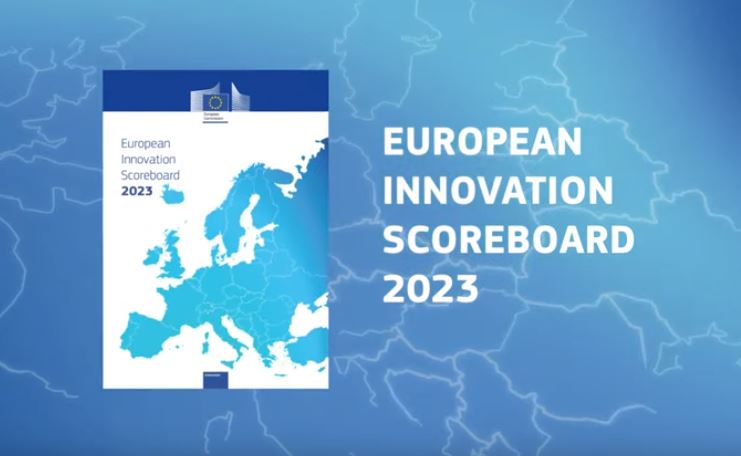European Innovation Scoreboard 2023: Western Balkans Innovation Performance

All Western Balkan economies are considered modest or Emerging Innovators according to the European Innovation Scoreboard 2023 (EIS).
The EIS classifies economies into four performance groups: Innovation leaders, Strong innovators, Moderate innovators and Emerging innovators.
It captures 12 innovation dimensions and distinguishes between four main types of activities – Framework conditions, Investments, Innovation activities, and Impacts. Overall, it measures innovation performance with 32 indicators.
The EIS is designed to inform policy makers about implementing adequate policies which aim to address key societal challenges.
On average, innovation performance in Europe has increased by about 8.5% between 2016 and 2023. Although the innovation performance of most EU Member States has improved, an innovation divide remains between more and less affluent EU Member States.
How about the Western Balkans' Innovation Performance?
Out of five Western Balkan economies covered by the EIS, only Serbia’s performance is above the average of the Emerging Innovators.
Despite this, Serbia’s performance is at two-thirds of the EU average (63.2%). Other economies are below a half of the EU average, ranging from 47% in Montenegro, 46.3% in North Macedonia, 41.1% in Albania and 36.2% in Bosnia and Herzegovina.
As table below illustrates, the region performs exceptionally well - and above the EU average in 2023 - in product and business process innovators indices. In addition, it performs reasonably well in employment impacts and environmental sustainability.
On the other side of the spectrum, key obstacles are finance and support (R&D expenditure in the public sector, venture capital expenditures and direct government funding and government tax
support for business R&D) and intellectual assets.
As one could expect, the region is suffering from limited human resources measured in new doctorate graduates (in STEM fields), population aged 25-34 with tertiary education and lifelong learning.
Similarly, the region has to step up efforts in both, digitalisation (broadband penetration and % of population with adequate digital skills) and firm investment (R&D expenditure in the business sector, non-R&D innovation expenditures and innovation expenditures per person employed in innovation-active enterprises).
| Albania | Bosnia and Herzegovina | Montenegro | North Macedonia | Serbia | Western Balkans average |
| SUMMARY INNOVATION INDEX | 41.1 | 36.2 | 47 | 46.3 | 63.2 | 46.7 |
| Human resources | 53.6 | 9.6 | 36.3
| 32.8 | 47.3 | 35.9 |
| Attractive research systems | 42.0 | 37.3 | 48.1
| 84.8 | 46.7 | 51.8 |
| Digitalisation | 4.1 | 26.9 | 47.7
| 43.2 | 59.2 | 36.2 |
| Finance and support | 0.0 | 19.7 | 14.5
| 15.6 | 39.2 | 17.8 |
| Firm investments | 0.0 | 0.7 | 23.3
| 40.0 | 101.9 | 33.2 |
| Use of information technologies | N/A | 63.5 | 69.3
| 32.8 | 79.7 | 61.3 |
| Innovators | 70.4 | 110.5 | 132.5
| 60.0 | 132.2 | 101.1 |
| Linkages | 41.3 | 15.4 | 48.3
| 50.0 | 65.4 | 44.1 |
| Intellectual assets | 7.4 | 7.7 | 16.2
| 14.4 | 17.8 | 12.7 |
| Employment impacts | 37.5 | 78.6 | 105.8
| 30.7 | 99.5 | 70.4 |
| Sales impacts | 53.2 | 28.6 | 29.8
| 68.8 | 72.1 | 50.1 |
| Environmental sustainability | 98.6 | 89.7 | 56.0
| 87.3 | 27.6 | 71.84 |
Innovation gap
North Macedonia and Serbia are closing performance gap compared to the EU, whereas this gap is becoming larger for the remaining economies in the region.
For North Macedonia and Serbia, performance between 2016 and 2023 has increased at a rate above that of the EU (14.5 and 15.1 respectively, compared to EU's 8.5%).
Montenegro is at a rate just below the EU average, while Albania is slightly behind.
Bosnia and Herzegovina’s performance has decreased at a lower rate (-0.4).
| Performance increase compared to EU rate (8.5%-points) | Performance gap to the EU | |
| Albania | 6.6 Increasing at a lower rate | Becoming larger |
| Bosnia and Herzegovina | - 0.4 Decreasing at a lower rate | Becoming larger |
| Montenegro | 8.4 Increasing at a rate just below the EU average | Becoming larger |
| North Macedonia | 14.5 Increasing higher than the EU average | Becoming smaller |
| Serbia | 15.1 Increasing higher than the EU average | Becoming smaller |
Note that results for Albania are less reliable due to limited data availability, while Kosovo* is not included in the EIS.
This year's European Innovation Scoreboard portrays a similar picture to the Global Innovation Index (GII) 2023. As an illustration, three Western Balkan economies moved up the rankings out of 39 European economies covered in the GII 2023.
Undoubtedly, more has to be done to close the innovation gap between our region and the EU.
Strengths and weaknesses of Western Balkan innovation systems
The EIS provides a comparative assessment of the research and innovation performance of each economy, including the relative strengths and weaknesses of their research and innovation systems. It assists policy makers assess areas in which they need to concentrate efforts to boost their innovation performance.
The following table shows strong and weak points in the region's innovation ecosystems.
| Relative strengths | Relative weaknesses
| Strong increases since 2016 | Strong decreases since 2016 | Strong increases since 2022 | Strong decreases since 2022 | |
| Albania | Environment-related technologies Sales of innovative products Product innovators Lifelong learning Population with tertiary education
| People with above basic overall digital skills R&D expenditures in the public sector R&D expenditure in the business sector Medium and high-tech goods exports Public-private co-publications | Environment-related technologies Population with tertiary education Most cited publications | Foreign doctorate students Innovative SMEs collaborating with others Product innovators | Design applications Most cited publications
| Innovative SMEs collaborating with others Knowledge-intensive services exports Product innovators |
| Bosnia and Herzegovina | Environment-related technologies Product innovators Business process innovators Employment in innovative enterprises Sales of innovative products
| Non-R&D Innovation expenditures Innovation expenditures per employee Lifelong learning Design applications R&D expenditures in the public sector | International scientific co-publications Public-private co-publications Broadband penetration
| Government support for business R&D R&D expenditures in the public sector PCT patent applications
| Most cited publications PCT patent applications Government support for business R&D
| Knowledge-intensive services exports Population with tertiary education Trademark applications |
| Montenegro | Product innovators Employment in innovative enterprises Enterprises providing ICT training Business process innovators Population with tertiary education
| Design applications Government support for business R&D Trademark applications Doctorate graduates R&D expenditure in the business sector
| Broadband penetration Population with tertiary education International scientific co-publications
| Foreign doctorate students Job-to-job mobility of HRST Trademark applications
| Broadband penetration Most cited publications Doctorate graduates
| Knowledge-intensive services exports Enterprises providing ICT training International scientific co-publications
|
| North Macedonia | Foreign doctorate students Environment-related technologies Non-R&D Innovation expenditures Medium and high-tech goods exports Population with tertiary education | Design applications R&D expenditure in the business sector Government support for business R&D Lifelong learning Doctorate graduates
| Foreign doctorate students Job-to-job mobility of HRST Environment-related technologies
| Enterprises providing ICT training R&D expenditures in the public sector Doctorate graduates
| Environment-related technologies Foreign doctorate students Most cited publications | Job-to-job mobility of HRST PCT patent applications Medium and high-tech goods exports |
| Serbia | Non-R&D Innovation expenditures Product innovators Employment in innovative enterprises Business process innovators Innovation expenditures per employee | Air emissions by fine particulate matter Design applications Resource productivity Government support for business R&D PCT patent applications | Product innovators Broadband penetration Employment in innovative enterprises
| Enterprises providing ICT training Environment-related technologies Medium and high-tech goods exports
| Enterprises providing ICT training Broadband penetration Business process innovators
| Innovative SMEs collaborating with others Environment-related technologies Product innovators
|
European innovation performance
The new top innovator with the best performance in the EU is Denmark, overtaking Sweden after a few years in leading position.
Other Innovation Leaders are Sweden, Finland, the Netherlands, and Belgium.
Austria, Germany, Luxembourg, Ireland, Cyprus, and France are Strong innovators, performing above the EU average.
The Moderate European innovators group is lead by Estonia, Slovenia, Czechia, Italy, Spain, Malta, Portugal, Lithuania, Greece and Hungary.
All Emerging Innovators are former Eastern European economies: Croatia, Slovakia, Poland, Latvia, Bulgaria and Romania.
